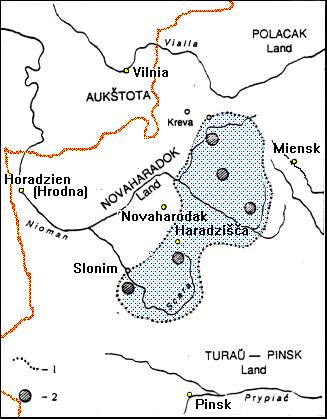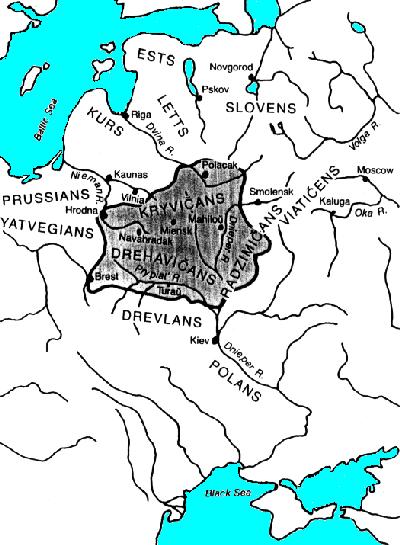The origins of the Grand Duchy of Litva (Lithuania)
According to the Belarusan historian Mikola Jermalovic, the 13th century "conquest" of
Belarus by a Baltic Litva is an undocumented myth created in the 16th century. In the course of
time, the "conquest" became a convenient historical dogma which no one bothered to question
since it supported the status quo in Eastern Europe.
Mr. Jermalovic traces the beginning of Litva`s statehood back to 1246 AD when Mindouh, a
duke of Baltic origin, came to power in the duchy of Novaharodak
(Navahradak in
modern Belarusan, Novogrudok in Russian and Nowogrodek in Polish.) He and
his son, Voisalk, expanded the duchy to encompass south-western Belarus and established the
state later called the Grand Duchy of Litva. The ethnic relationships in the region during the
13th century are illustrated on the map...

Ethnic relationsships in 13th century
southwestern modern Belarus.
1: Aproximate boundaries of Ancient Litva
2: Present toponymics (place names) Litva
The brown line shows the borders
of Belarus today.
| Where was ancient Litva?
Mr.Jermalovic, however, places the ancient Litva to the east of the duchy of
Novaharodak in the upper reaches of the river Nioman. Mr.Jermalovic quotes references from
Eastern European and German chronicles to substantiate this claim. In addition, he has
found five relevant place names in this region - vilages named Litva.
Who were the inhabitians of this region? The 12th century annals tell us that the
inhabitans of Litva were paying taxes to the duchy of Polacak and there are many
references to Litva serving as mercentary soldiers in the military campaigns of the
dukes of Polacak. In fact, the Lithuanians developed a reputation for military
prowess. Some hisstorians point out that the suffix -tva in "Litva" is one commonly
used in Slavic collective nous to describe.
|
 ... Initially, the entire Belarusan ethnic area was inhabited by Baltic tribes. In the
sixth-to-seventh centuries, Slavic tribes came from the west. The Slavs fused with the Balts
to form a new Balto-Slavic nation - the ancestors of today's Belarusans. The prevalent
language became Slavic - Old Belarusan - which retained many Baltic elements in its
pronunciation and vocabulary. Baltic elements are still recognizable in the folklore
(dances, songs, costumes, folk ornaments, etc.) and toponymics (place names) of the
present-day Belarus.
... Initially, the entire Belarusan ethnic area was inhabited by Baltic tribes. In the
sixth-to-seventh centuries, Slavic tribes came from the west. The Slavs fused with the Balts
to form a new Balto-Slavic nation - the ancestors of today's Belarusans. The prevalent
language became Slavic - Old Belarusan - which retained many Baltic elements in its
pronunciation and vocabulary. Baltic elements are still recognizable in the folklore
(dances, songs, costumes, folk ornaments, etc.) and toponymics (place names) of the
present-day Belarus. The Slavs belonged to tree main tribes: the
Kryvicy, who settled in northern and central Belarus, the Dryhvicy(Drehavicans), who settled
in the south along the river Prypiac' and Radzimicy(Radzimicans) who settled in the upper Dniapro
(Dnepr) region. Two other tribes, the Severianie and the Viacicy(Viaticens), settled
further east and only parts of their former territories are now considered ethnically Belarusan.
(See also left the map: Historical beginnings of Belarus:
Location of tribes in and around future Belarus toward the ninth century.)
These Slavic tribes all adopted Christianity in its Eastern Orthodox from the Kievan Rus.
For some time they were also politically dependent from Kiev. However, the Kryvicy soon
established their own state in the north - the Duchy of Polacak. Later, the duchies of
Turau-Pinsk and Novaharodak were established in the south and Southwest respectively. The
territory of the duchy of Novaharodak, which had been colonized by both the Kryvicy and the
Dryhvicy, extended along the Nioman river between Horadzien (currently know as Hrodna
or Grodno) in the west and Novaharodak in the east.
The duchy of Novaharodak was
virtually surrounded by unassimilated Baltic tribes: the
Jacviahi(Yatvegians) in the west (who were later belarusianized), the Nalscany in the
north, the Litva in the east and Northeast, and the area called Aukstota in
the south-eastern part of modern Lithuania. Another Baltic tribe, the Samogitians,
who lived between Aukstota and the Baltic Sea, did not merge with the Slavs but remained a
separate ethnic group. It was the Samogitians and the inhabitants of Aukstota who
became the ancestors of today's Lithuanians.
Aukstota - which means highland in
Lithuanian - is nowhere mentioned as such in
the medieval chronicles and did not seem to be a political entity. Many of its place names
contain the word aukstas, or high, while Samogitia, further to the west,
means lowland. The city of Vilna (currently know as Vilnius) the present capital of
Lithuania, is in Aukstota and Lithuanian scholars consider Aukstota to be the heart of the
Lithuanian ethnic area. They claim that Aukstota was the location of the original Litva and
that it was from here that Duke Mindouh (Mindaugas in modern Lithuanian) left to conquer the
adjoining Duchy of Novaharodak and established the Grand Duchy of Litva.
However, the separate ethnic character of Litva is supported by the non-Slavic names of
their leaders - Mindouh, Vojsalk, etc. Mr. Jermalovic feels that Litva
referred to an unassimilated Baltic ethnic island.
The role of Duke Mindouh
Mr. Jermalovic analyses the role of Duke Mindouh. He concludes that Litva, led by
Mindouh, did not conquer the duchy of Novaharodak, but it was the other way round. The
duchy of Novaharodak, led by Mindouh, conquered Litva!
According to the chronicles of the
period, Mindouh suffered military defeats in his mercenary activities and domestic rivals
forced him to flee from Litva to Novaharodak. In Novaharodak, Mindouh converted to Orthodox
Christianity and was elected its duke. Then Mindouh attacked Litva. Mindouh was ready for
revenge and, according to the chronicles, "he occupied Litva" and ousted his enemies. This was
the first step in the formation of the Grand Duchy of Litva.
The unification process
Novaharodak developed into an important political, economic and cultural center in
Eastern Europe and played a key role in the growth of the Grand Duchy, and in uniting the
other Belarusan lands under its rule. The emblem of Novaharodak - Pahonia, a rider on
horseback with a sword in his hand - became the emblem of the Grand Duchy.
The adjoining Baltic areas of Litva and Nalscany were subdued by force; whereas the old
Belarusian principalities of Pinsk(see also Pinsk),
Polacak(see also Polacak), Viciebsk and others joined the new state
voluntarily. The Litvanians of the Upper Nioman were gradually assimilated (belarusianized)
but retained their name which was adopted by the entire nation. The unification of
Belarusan and Litvanian lands was part of the historical process of rapprochement and helps
to explain the dominant role of the Belarusian culture and the official status of the
Belarusan language in the Grand Duchy.
One riddle remains: how did the name of the insignificant, conquered Litva get
transferred to the powerful Grand Duchy? The history of Europe provides several parallels:
the German state of Prussia was named after the Baltic Prussians who were conquered and
completely germanized. Similarly, Britain - originally the land of the Celtic Britons - now
describes the empire, founded by their conquerors, the Anglo-Saxons.
For the preparation of this Page I have used the article "The Origins of the Grand Duchy of
Litva (Lithuania)" after J.Kreuski by the newsparer "Belarusian Review" Summer 1991
Back to Origins of GDL main page
 This file is a part of the Virtual Guide to
Belarus - a collaborative project of Belarusian
scientists and professionals abroad. VG brings you the most extensive
compilation of the information about Belarus on the Web.
This file is a part of the Virtual Guide to
Belarus - a collaborative project of Belarusian
scientists and professionals abroad. VG brings you the most extensive
compilation of the information about Belarus on the Web.
Please send your comments to the authors of
VG to Belarus 
History
| Statehood | Culture
| Law and Politics | Cities
| Nature and Geography
| Travel
| Global Resources
| Dictionaries
| Chernobyl | Genealogy
| Industry
 VG to Belarus
VG to Belarus
Disclaimer

 ... Initially, the entire Belarusan ethnic area was inhabited by Baltic tribes. In the
sixth-to-seventh centuries, Slavic tribes came from the west. The Slavs fused with the Balts
to form a new Balto-Slavic nation - the ancestors of today's Belarusans. The prevalent
language became Slavic - Old Belarusan - which retained many Baltic elements in its
pronunciation and vocabulary. Baltic elements are still recognizable in the folklore
(dances, songs, costumes, folk ornaments, etc.) and toponymics (place names) of the
present-day Belarus.
... Initially, the entire Belarusan ethnic area was inhabited by Baltic tribes. In the
sixth-to-seventh centuries, Slavic tribes came from the west. The Slavs fused with the Balts
to form a new Balto-Slavic nation - the ancestors of today's Belarusans. The prevalent
language became Slavic - Old Belarusan - which retained many Baltic elements in its
pronunciation and vocabulary. Baltic elements are still recognizable in the folklore
(dances, songs, costumes, folk ornaments, etc.) and toponymics (place names) of the
present-day Belarus.